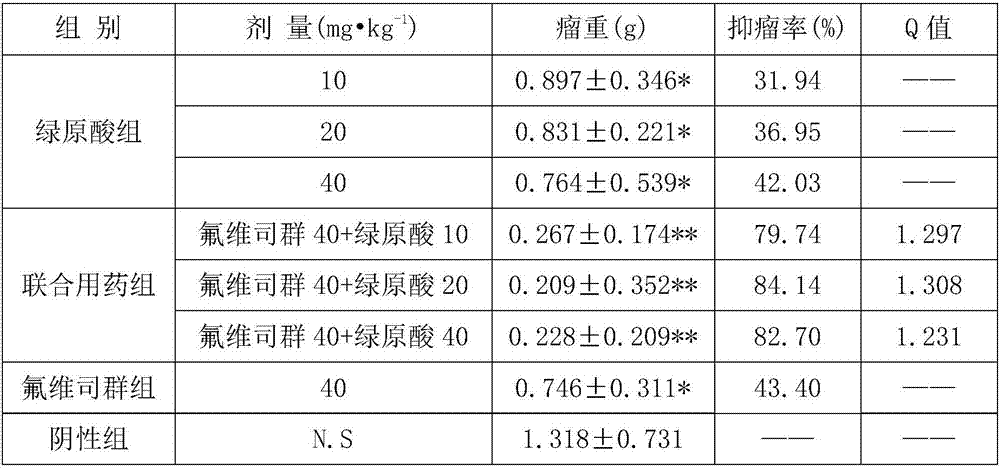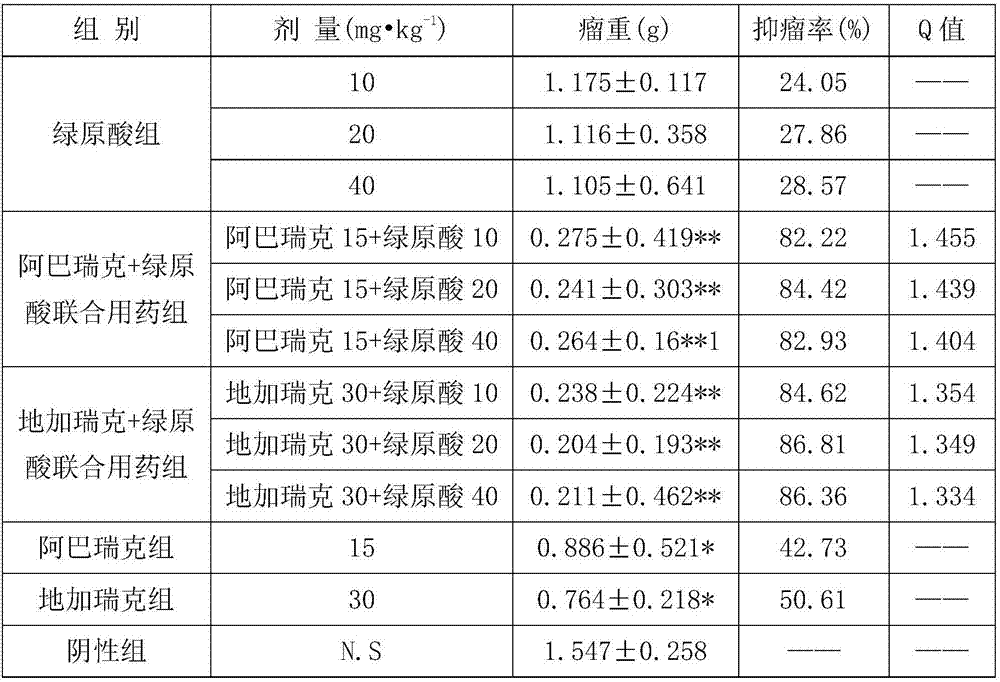Combined drug used for treating cancers
A drug and cancer technology, applied in the field of combined drugs for the treatment of cancer, can solve the problems of high toxicity and side effects, poor therapeutic effect, and poor selectivity of anti-malignant tumor drugs, achieve low toxicity, good clinical application prospects, and overcome toxic and side effects big effect
- Summary
- Abstract
- Description
- Claims
- Application Information
AI Technical Summary
Problems solved by technology
Method used
Image
Examples
Embodiment 1
[0019] Example 1 In vivo animal experiment of chlorogenic acid combined with fulvestrant to treat breast cancer in mice
[0020] 1. Materials
[0021] Test drugs: chlorogenic acid, fulvestrant.
[0022] Tested cell line: EMT-6 mouse breast cancer cell line.
[0023] Test animals: BALB / C-nu mice, ♀, body weight 16-21g.
[0024] 2. Experimental method
[0025] Take the cells in the logarithmic growth phase, digest them with trypsin until they are detached, and then add physiological saline to make a cell suspension. -1 (about 1×106 cells), inoculated under the left anterior armpit of mice, and randomly divided into groups according to body weight, respectively fulvestrant group, chlorogenic acid group, fulvestrant + chlorogenic acid combined drug group, Negative group, 6 rats in each group.
[0026] Fulvestrant was administered intraperitoneally once on the second day after inoculation; the chlorogenic acid group was administered intraperitoneally once a day from the second...
Embodiment 2
[0036] Example 2 In vivo animal experiments of chlorogenic acid combined with abarelix or degarelix in the treatment of prostate cancer in mice
[0037] 1. Materials
[0038] Test drugs: chlorogenic acid, abarelix, degarelix.
[0039] Tested cell line: RM-1 mouse prostate cancer cell line.
[0040] Test animals: Kunming mice, ♂, weighing 17-24 g.
[0041] 2. Experimental method
[0042] Take the cells in the logarithmic growth phase, digest them with trypsin until they are detached, and then add physiological saline to make a cell suspension. -1 (Containing about 1×106 cells), inoculated under the left anterior armpit of mice, and randomly divided into groups according to body weight, namely abarelix group, degarelix group, chlorogenic acid group, abarelix+green Ortho-acid combination group, degarelix + chlorogenic acid combination group, negative group, 6 rats in each group.
[0043] The abarelix group was given intraperitoneal injection once on the second day after inoc...
Embodiment 3
[0053] Example 3 Animal Experiments of Combining Chlorogenic Acid and Abarelix to Prepare Anti-multidrug Resistance
[0054] 1 material
[0055]Test drugs: chlorogenic acid, abarelix.
[0056] Tested cell line: RM-1 mouse prostate cancer cell line, which was induced by increasing the concentration of abarelix to RM-1 cell line, and established by clonal screening, and cultured without drug before the experiment.
[0057] Test animals: Kunming mice, ♂, weighing 17-24 g.
[0058] 2 Experimental methods
[0059] 2.1. Establishment of experimental animal tumor models
[0060] The drug-resistant cell lines after drug removal were adjusted to a cell concentration of 1×10 with culture medium. 7 / m1, inject 1×10 subcutaneously in the right armpit of mice 7 / ml of cells, each 0.1ml.
[0061] 2.2. Administration method
[0062] When the average diameter of the tumor reaches 100mm 3 Afterwards, the groups were divided into abarelix medication group, chlorogenic acid + abarelix gr...
PUM
 Login to View More
Login to View More Abstract
Description
Claims
Application Information
 Login to View More
Login to View More - R&D
- Intellectual Property
- Life Sciences
- Materials
- Tech Scout
- Unparalleled Data Quality
- Higher Quality Content
- 60% Fewer Hallucinations
Browse by: Latest US Patents, China's latest patents, Technical Efficacy Thesaurus, Application Domain, Technology Topic, Popular Technical Reports.
© 2025 PatSnap. All rights reserved.Legal|Privacy policy|Modern Slavery Act Transparency Statement|Sitemap|About US| Contact US: help@patsnap.com


